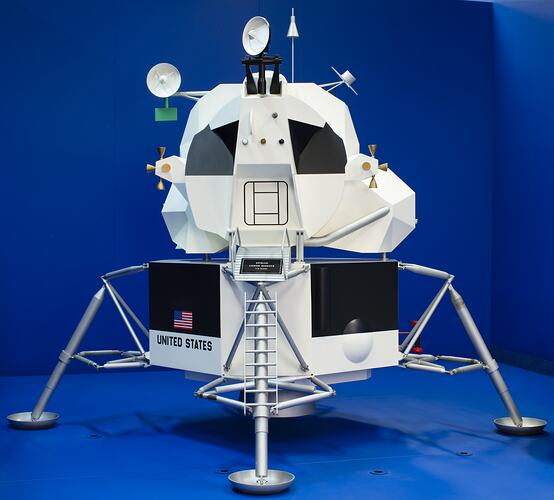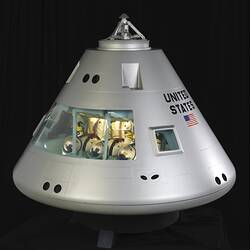Summary
A 1:3 scale model of the Apollo 11 Lunar Lander module, 'Eagle', manufactured by the Dayton Scale Model Co in the United States of America in the 1970s. It was acquired in 1978 and used the following year for a 10th anniversary exhibition, commemorating the first landing of humans on the moon in 1969.
The NASA Apollo 11 spacecraft left earth from Cape Kennedy, Florida, in the United States of America on 16 July 1969. A few days later, on 20 July 1969, the Apollo 11 Lunar Lander, named 'Eagle', transported the first humans to the moon. Commander Neil Armstrong and Lunar Module pilot Edwin 'Buzz' Aldrin walked on the surface of the moon, the first humans to do so. Command Module pilot Michael Collins maintained lunar orbit while his crewmates visited the moon surface. The crew landed back on earth on 24 July 1969.
The actual Apollo spacecraft were made up of three separate units - the Command, Service and Lunar Lander modules. The Lunar Lander was designed to disconnect from the Command and Service modules in lunar orbit and descend to the moon's surface with two astronauts. It consists of two sections; the Descent stage which remained on the moon, and the Ascent stage which returned the astronauts to the Command and Service Module (containing a third astronaut) in the moon's orbit. The Command module then disconnected from the Ascent stage and the Service module and returned to Earth with the three astronauts.
This Lander model depicts the two windows used for landing manoeuvres, a hatch and ladder for exit to the surface, four legs, and the various instruments and propulsion components to control the modules.
Physical Description
Octagonal white painted wooden base unit with silver funnel in centre underneath and four silver legs. A smaller white painted wooden unit sits on top with dishes and antennae.
More Information
-
Collecting Areas
-
Acquisition Information
Purchase
-
Modelmaker
Dayton Scale Model Co., Dayton, Ohio, United States of America, circa 1978
-
Manufacturer of Item Modelled
Grumman Aerospace Corporation, Long Island, New York, United States of America, 1969
-
User of Item Modelled
National Aeronautics & Space Administration (NASA), United States of America, 1969
-
Inscriptions
On front of model: [Coloured United States of America flag] / UNITED STATES On Egress Platform: APOLLO / LUNAR MODULE / 1/3 Scale
-
Classification
-
Category
-
Discipline
-
Type of item
-
Overall Dimensions
2420 mm (Width), 2330 mm (Depth), 2700 mm (Height)
Measured as assembled [M.Vaughan, 22/2/2019]
-
Model Scale
1:3
-
Keywords
Space Flight, Spacecraft, Space Technology, Lunar Exploration, Exploration, Models & Modelmaking, Astronauts, Lunar Observations, The Moon



